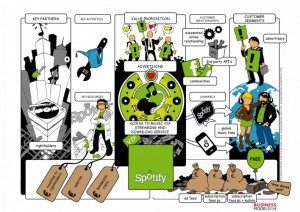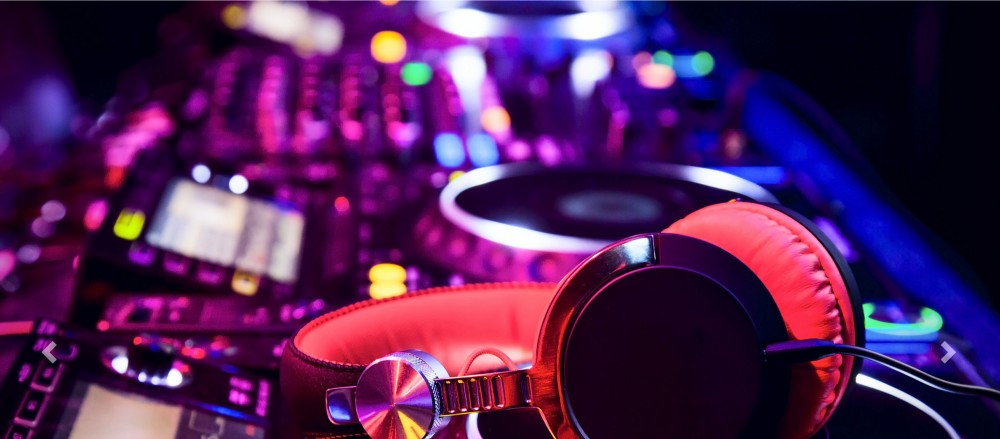“The DEATH of selling music. And the rebirth of live music and parties. When I was younger you played gigs to sell your records and you’d lose money. And now you don’t have records to sell but you make money cos people still want to go out and party.” Fatboy Slim

Source: Business Model Inc. http://www.businessmodelsinc.com/free-drives-paid-the-business-model-of-spotify/
Following extensive background research on existing sites and study of the inner workings of social media based on what was taught in our class I came up with the business model for miXXerS. A number of business models are emerging around music and web based online social networks are the key to success. The increasing dominance of music streaming and the pervasiveness of online social networks combined with the lingering longing to be part of an offline social musical experience can converge through bringing different types of music lovers together through miXXerS. A 2013 report from Rethink Music on New Business Models in the music industry found that digital channels are now major source of income for record labels and publishers. Even Universal Music made a deal with Full Screen and Maker Studios, (2 YouTube Partner Channels) that have 4 billion views a month.
“A broad perspective takes into account the many types of “currency” that have evolved in the digital paradigm to encompass not just money, but amounts of time, attention, personal data and social participation in music experiences. Music consumers appear to be listening and interacting with music more than ever; the total volume of music purchases reached an all-time high in 2012, totaling over 1.65 billion units, up 3.1% from the previous year thanks to growing consumption of digital formats (digital albums were up 14% and digital tracks up 5%).” Source: Rethink Music
In addition, in recent years live music also continues to be important though Live Nation Entertainment continues to be dominant globally. Using a vertical integration strategy they acquired the ticketing company Ticketmaster and some other promotion companies but they also operating about 100 notable live music venues around the world. In addition music festivals have become more popular. (Find out more here)
DJs are now also an important component of both the party and music scene. DJs are ‘the new rock stars’ and Forbes has called them (those who play electronic dance music), “Electronic Cash Kings”. In addition, today more than ever it has never been more productive to be an independent artist. While the marketing might of the industry can be useful Musicians can use social media to their advantage.
Case Study: The EDM Movement
“During the past five years, a seemingly desperate “arms race” has occurred, with many large U.S. conglomerates chasing the ever-growing Electronic Dance Music (EDM) market. This “gold-rush” mentality reached new heights with the recent announcement of the first ever mass market EDM movie from 20th Century Fox and EDM producer mogul Diplo, and the acquisition of Beatport, the biggest online music store and community for DJs, by SFX Entertainment for approximately $50 million. The SFX move is just another step in the $1 billion investment plan announced some time ago by SFX’s leader Robert Sillerman, who aims to extend his empire into the EDM industry, which is now worth over $4 billion per annum and showing huge increases annually in ticket sales and radio airplay. Last year, Live Nation bought Los Angeles-based electronic dance music promoter Hard Events, just a few months after their acquisition of another big popular EDM event organizer, U.K.-based Cream Holdings, promoter of the Creamfields festivals. It is evident that many perceive the growing force of the EDM movement as a road to escape from the darkest era of the music business.Not surprisingly, with the music business shifting toward live events and festivals, wellknown corporate players are seeking a slice of the newly appetising dance music pie. “
Source: Rethink Music
Taking the Long Tail approach as advocated by Chris Anderson we have found that their is a gap in the market for a social network site that combines the elements we have described. We believe that a combination of elements can help such a site to potentially become a very sustainable and viable business in the entertainment industry. According to Anderson the Long Tail refers orange part of the sales chart below, which is a demand curve for the entertainment industry. “The vertical axis is sales; the horizontal is products.” The red part of the curve illustrates the hits but it is in the orange part (non-hits/niches) that growth in the entertainment industry is coming from and miXXerS can successfully fulfil a niche (or a sweet spot), which has the potential to expand tremendously.

http://www.longtail.com/about.html
According EDM the musician today can be considered a ‘company’ not just a brand. So can the DJ. In addition ‘24/7 connectivity’ especially via mobile enables artists and concert/party producers to maintain a direct relationship with the fans and customers. Genuine recognition of fans is important in the development of this site and the digital natives and millennials we target will expect this.
“a new type of fan or client has emerged: always connected, well informed, and more able to select and choose. Fans and clients have become more assertive and less gullible. They demand transparency and claim personal contact with their idol or provider”. EDM
A Nielsen study of more than 4,000 music consumers found that they thought that products and services on offer are not very engaging. They said that they would be willing to pay if the industry offered more.
“Nielsen found there could be potential incremental revenue of $450 million to $2.6 billion if artists, managers and labels offered a better set of products and experiences to fans… exclusive music merchandise, such as signed posters, limited edition tshirts, handwritten lyrics, and even direct personal experiences such as a 30-minute Skype conversation with an artist could generate a potential $450 million to $2.6 billion in annual incremental revenue…offers as mentioned above are attractive not only to consumers Nielsen calls “Aficionados”, (the most active music buyers (53%)), but even to a sizable percentage of what Nielsen calls “Ambivalent consumers” (22%). 5 Billboard.com
E-commerce Revenue model
Given pressure to make money often stifles growth we would need to get Venture Capitalist (VC) funding to be able to proceed with this venture, rather than have a lot of pressure to generate income at the start. This was one of the reasons sited for the downfall of mySpace. We do not want to compromise our vision and therefore make the site unattractive to our users. Technology moves quickly as has aided the downfall of some music sites (e.g. failure to adapt to mobile or the move from proprietary software to open source). Therefore procuring VC funding will be important for our model. miXXers will provide a social network that is free for all music and party/concert lovers to use, through the use of a freemium service. However, given the research we could explore adding premium content/services for users in the future when we increase our user base. DJs, Musicians, party/concert producers and promoters will have to pay for special features like advertising. We will therefore use an advertising business model. If musicians, DJs and Party/concert producers would like additional services they can access them for a trial period of 1 month after which they will have to pay for those service. Premium services will pay for free services to all.
Keeping the service free for the user will enable the site to attract more users and therefore make it more attractive to paying customers. In line with the ‘direct network effect’ the value of our site will increase as more people use it so it is essential to keep access free to increase our valuable user base. This would by extension help to increase advertising revenue through the ‘indirect network effect’ as usage will lead to a larger number of complementary and valuable services to DJs, musicians and party/concert promoters who advertise there which will also lead to a ‘cross-network effect’ as well. In addition to advertising, given users are not just the consumer of information about parties but also the producers of information on the parties they attend and the music they listen to this information is valuable to musicians, DJs as a well as party/concert producers. We will seek popular parties in various regions and those with active social media networks to help create strong local network effects that would be invaluable to the growth of the site.
A formula for potential revenue stream was also created (by Yash).
Business Models: APIs
We will use APIs which provide for 3rd party applications and use which will require some revenue sharing and marketing for our site and those that partner with us as well as some degree of data sharing if necessary. To avoid issues that arise with licensing we will integrate other site offerings into our site. Tracks or playlists from SoundCloud and MixCloud for example will also be able to be be embedded in the site and users will be able to login via their Facebook accounts.
Value to Users
- Book DJs
- Like music/musicians/DJs/parties
- Make recommendations/rate experience (recommender system)
- Party notifications
- Find people to attend parties with
- Connect with others that like similar music
- Enter competitions/Win tickets
- Follow and Potentially Meet/Chat with musicians/DJs at events and online (including through competitions)
- Narrow location search of parties in neighbourhoods all over the world
- Find information about events
- Interact with other interested in the same events and music
- More opportunity to discover new music
- See how many men and women will attend a party/concert (gender demographics may be a factor in deciding whether to attend a party)
Target group: Millennials, Initially University Students, Young Middle Income professionals
Based on user feedback and additional research some additional features we will consider adding as the site develops includes
- Avatars for users
- A reward System for the most active users on the site
- Premium membership with additional features based on user demand
Value to Musicians and DJs
Fans want to be close to a musician or DJ and unlike a record no-one ‘owns’ the artist’s or DJ’s fans yet they can also be a much better leveraged tangible asset by the musicians, DJs and party producers they follow. The site will generate valuable data on these fans and their opinions in one place and supports a paradigm shift in the entertainment industry which recognises the importance of this. Musicians no longer have to rely on music publishers for marketing and distribution for self-published content can also launch careers once a fanbase is created and connected.
| Gain new followers |
Musicians |
DJs |
Party/Concert Producers |
| Closer relationship with fans |
Musicians |
DJs |
Party/Concert Producers |
| Data: Listener/fan/party demographics |
Musicians |
DJs |
Party/Concert Producers |
| Find information on parties/concerts |
Musicians |
DJs |
Party/Concert Producers(compare party information) |
| Build fanbase |
Musicians |
DJs |
Party/Concert Producers |
| Advertise |
Musicians |
DJs |
Party/Concert Producers |
| Self publish music/ integrate music from other sites |
Musicians |
DJs |
|
In the future we can also consider
- Working with non-music brands to gain sponsorship for musicians and our site
- Revenue sharing with party/concert producers for users who purchase tickets through visiting our site.
Premium services for Musicians/DJs/Party producers/promoters
| Free |
Registration |
Mobile Access |
Provide prizes/competitions |
| Premium |
Contextualised Advertising |
Data Analytics |
Personalization |
There may be challenges if the users cancel after the trial but as we grow our user base we believe that this can be combatted. We think that this is an exciting time to explore a new path for entertainment.



